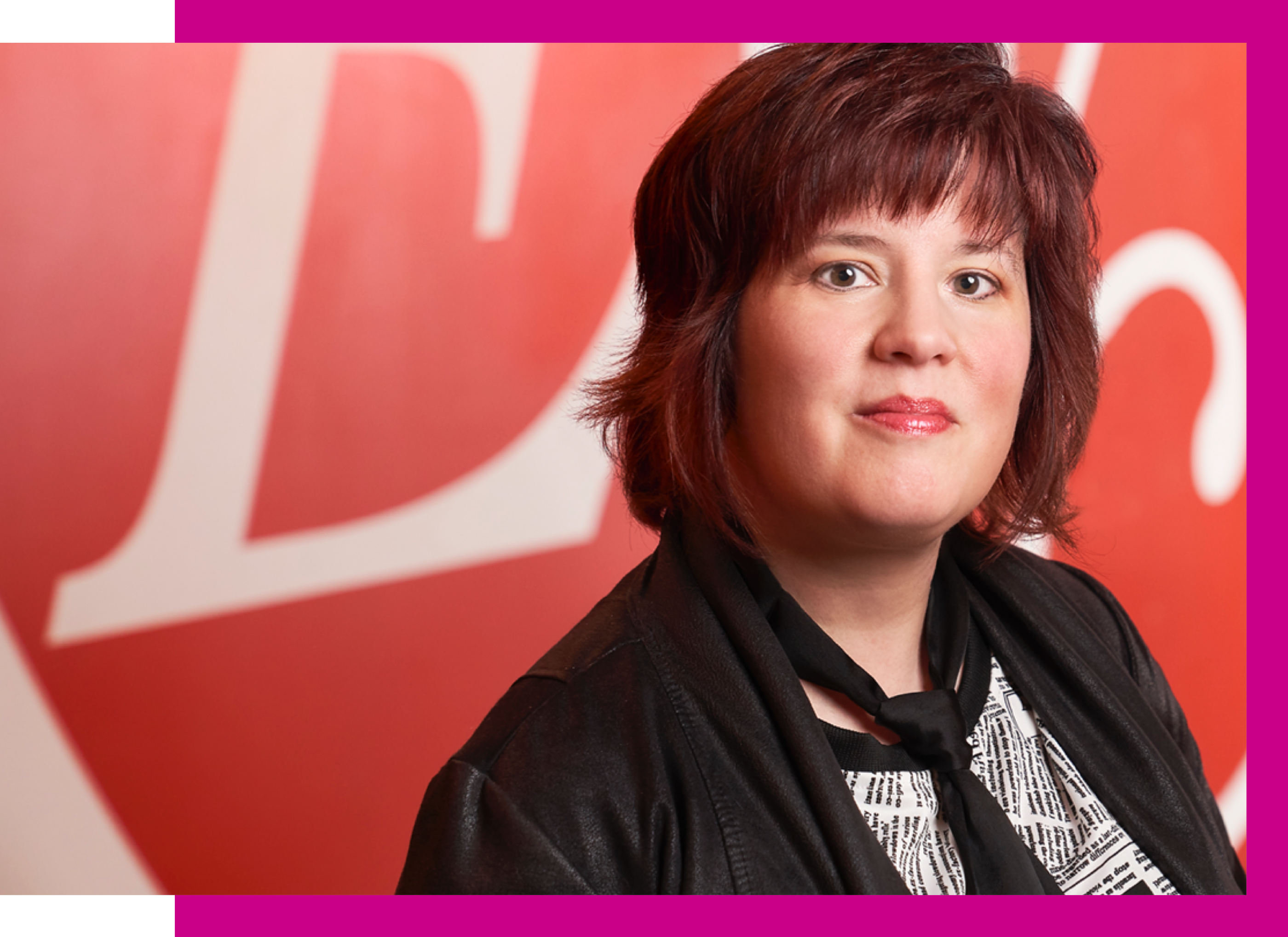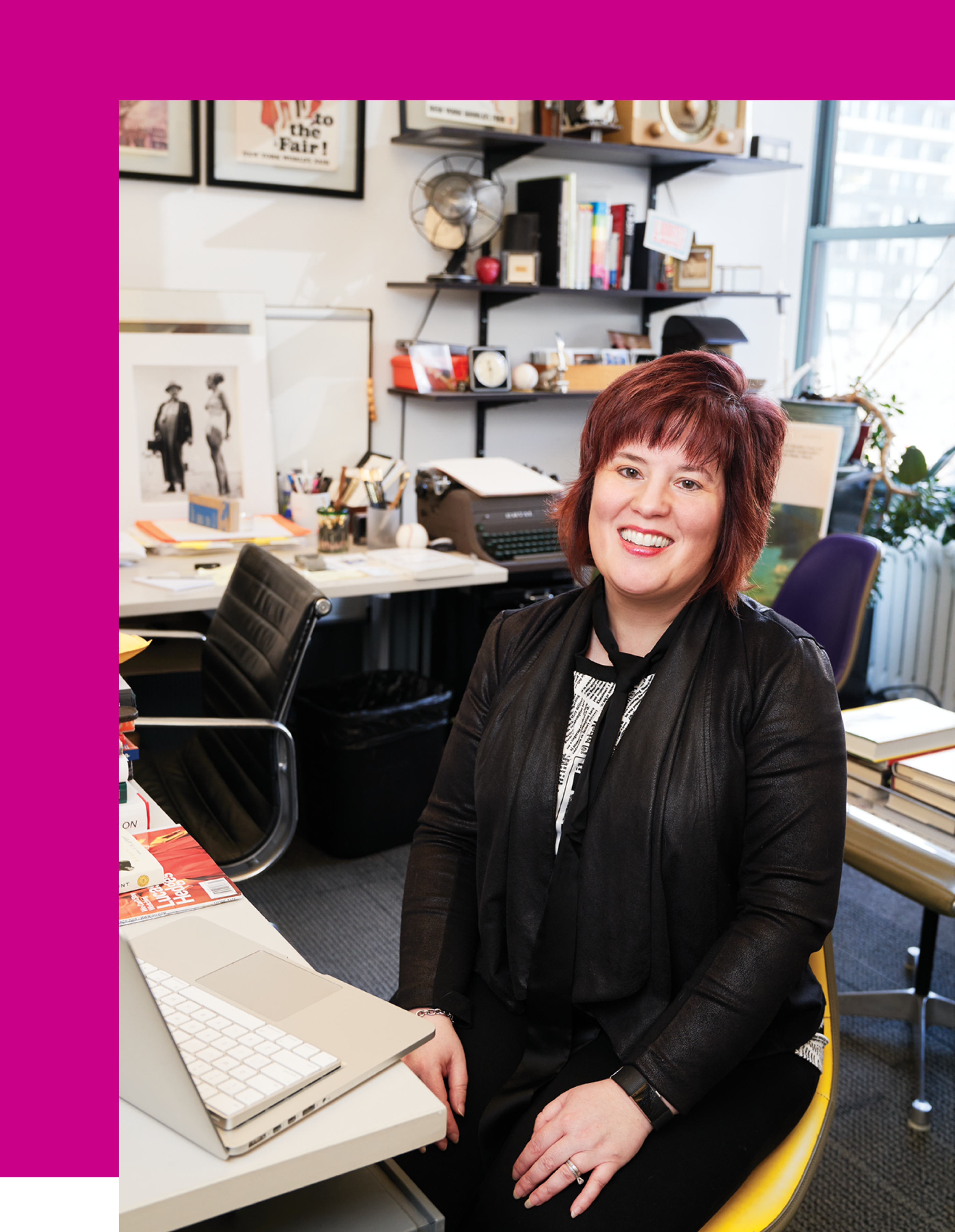Olivia Newton-John didn’t know it, but in the 1980s, her biggest fan was a third-grader living in the D.C. suburbs.
Culture Vulture
Jen Chaney ’94 talks TV
May 3, 2019
Story By
Sara K. Eskridge
Illustrations By
Sean McCabe
“When I was 7 or 8, I would watch ‘Grease’ over and over again, and I had the ‘Xanadu’ soundtrack practically memorized. If she was on TV, I had to record it so I could re-watch it and analyze it,” remembers Jen Chaney ’94 with a laugh. “I liked her for simple reasons — she seemed really nice, she was pretty and she had a great voice!”
Little did she know that her early obsession with a cultural icon was the embryo of a career immersed in television and popular culture. Chaney, who is now a television critic for the media outlet Vulture, doesn’t remember a time when she wasn’t obsessed with the small screen. She always knew more about her favorite shows than anyone else around her and found ways to incorporate her TV hobby into her schoolwork.
“Once we had to choose a person we admired, write a report about them and then attempt to do their job. I picked Steven Spielberg and I made a movie about a superhero who helped people become better at video games,” she recalls. “I was the first female director for a superhero movie!”
With such a strong affinity for popular culture, it seemed destined that Chaney would enter the entertainment industry in some capacity, but she points out that there were no people in her orbit that she could look to for inspiration. She wanted to be a writer, but her mother was concerned she wouldn’t be able to earn a living doing something creative. Once she came to William & Mary, however, she found herself molding her coursework to accommodate her passion for the arts.
“I was a DJ for WCWM, the campus radio station, and was also a features editor for a news program called Brave World News. We would try to feature local arts events like plays or exhibits at the Muscarelle, but sometimes there weren’t enough events to cover, and we would fill in with movie and TV reviews,” she says. “I started by recapping ‘Beverly Hills 90210’ and eventually added in ‘Melrose Place’ — really exploring the breadth of the genre!”
She parlayed an internship at the DC101 radio station into her first post-college job working for a small-town paper in Montgomery County, Maryland, following the time-worn advice that a journalist can only move up by starting at a small paper and gradually jumping to more prestigious publications. Deciding she wasn’t cut out for the vagabond lifestyle, she once again considered her options, at one point even working for nearly a year as a mid-career fellow on Capitol Hill. Eventually, she decided she wasn’t interested in politics and decided to aim big — working for The Washington Post.
Blazing the Digital Trail
It was the early 2000s and traditional news outlets were just beginning to explore the possibilities of online media. As a web producer and writer for The Post’s digital arm, Chaney was on the cutting edge of online content. In those days, the newsprint edition was governed by separate leadership than the digital version, but the old-fashioned rules that often define venerated institutions were still there.
Post employees were not allowed to attend political events for fear of being seen as partisan, and one editor famously did not even vote. Opinions were only appropriate in the editorial section. Even as they chafed against those traditional journalistic conventions, those on the digital side of the paper also sometimes felt like they worked for a start-up because there was a constant sense of innovation.
One of the ways they experimented was with entertainment reporting and blogging. When Liz Kelly created the Celebritology blog for The Washington Post in 2006, Chaney started writing celebrity news and, as in her college days, television recaps, which were still rare. When they started writing about ABC’s hit show “Lost,” that’s when their following really picked up.
“There was an entire online network that developed around this show, studying the background, looking for ‘Easter eggs’ and clues, writing entire posts dedicated to the significance of a book that showed up in a single scene,” she says. “Going online and doing research was as much a part of the experience as watching the show itself, and we wanted to be a part of that.”

"...I can't think about their feelings when I'm writing or else I'll censor myself. And that would be a disservice to the readers."
Chaney sees the evolution of this online television community as a huge step forward in television criticism. Whereas a critic used to receive a handful of episodes of a new show and write a review and recommendation based on this small sample, now they are invited to delve into individual episodes, continually grappling with a show and recalibrating, allowing their opinion to evolve over time. The critic becomes part of an ongoing conversation, instead of making a one-time pronouncement and moving on. Chaney cites the Netflix series “American Vandal,” a true-crime satire, as an excellent example of a show that benefits from such ongoing scrutiny.
“This is a show where it takes a few episodes to get invested in the characters — if we were using the old model, those few episodes were all that I, and by extension, my readers, would have had to go on when making the decision to watch, and I might have told people to pass,” she points out. “But by episode 5 or 6, I got really invested and by the end, I had completely changed my opinion, and I was able to write about that transformation in real time.”
The new model is also forgiving in that it allows critics to chime in on a show well into its run, which would have been unthinkable in the old print model. As long as the critic thinks they have something new or insightful to add, all voices are welcome. Critics and readers alike are also now encouraged to focus on smaller details, like costumes and production design, things that might have gone unnoticed before. So, when Chaney, who became a TV critic for Vulture in 2016, wanted to write an article devoted to the ponytail of the female lead on AMC’s “Better Call Saul,” her editor didn’t bat an eye.
“Kim Wexler has a perfect ponytail,” Chaney says. “When she’s got her life together, it’s tight, has a perfect curl and not a hair out of place. And as things go wrong, so does her hair. It’s a true litmus test for the character. These are the details I always wanted to read about as a child and didn’t even realize it.”
As the market for television criticism has grown online, so has Chaney’s profile, and now she sometimes gets to meet the people she writes about. She is occasionally invited on-set and into the writers’ rooms of some of America’s most beloved shows, including NBC’s “Parks & Recreation,” FX’s “The Americans” and, most recently, HBO’s “Veep.” It has given her a new appreciation for the sheer degree of thought and detail that goes into every episode of television, and she’s gained insight about the creative process.
With that closer connection comes the awareness that her subjects are often part of her audience. She was delighted to learn that Rhea Seehorn, the actress who plays Kim Wexler on “Better Call Saul,” re-tweeted her ponytail article. More surprising was the time she was chatting with “Lost” creator Damon Lindelof at a party, and she mentioned in passing that The Washington Post had done a basketball-style bracket to determine which was the best character on the hit ABC show. To her surprise, Lindelof was familiar with the bracket — he had participated in the contest.
Another time, she was in the writers’ room for HBO’s hit show “Veep,” only to find several of the staff in conversation about the early 1980s sitcom “WKRP in Cincinnati,” which she had written a piece about the week prior. It had been passed around the set ahead of her arrival. These are the interactions she tries not to think about when she’s writing.
“These conversations with directors, writers and show runners help inform what I write, because I learn their thought process,” she says. “But I can’t think about their feelings when I’m writing or else I’ll censor myself. And that would be a disservice to the readers.”

An Embarrassment of Riches
In this age of “Peak TV,” one would imagine there is no better job than being a television critic. Watching incredible programming, getting to think deeply on what you watch and write about your opinions, and having them be considered authoritative — for some, this is their idea of heaven. But for Chaney, who reviews an average of three shows a week, sometimes it can feel like too much of a good thing.
“Netflix will give you an entire season, so to do their reviews, I have to watch the whole show,” she points out. “That’s great if it’s an eight-episode season with 30-minute episodes, like Netflix’s ‘Russian Doll,’ but that’s not always the case. And there are always more shows coming down the pipeline, and sometimes you want to go back and check in with a show that you started earlier, so the work is never done!”
The increasing quality of the directors and actors coming to television has, for the most part, been a blessing. With this influx of quality talent has come a rich array of insightful, imaginative programming that allows a high level of viewer introspection and engagement. This represents a break from the traditional network television model, which emphasized formulaic plotlines and semi-predictable outcomes — TV that you don’t really have to pay attention to in order to enjoy.
Likewise, Chaney is among a chorus of voices pointing out that Peak TV on cable and streaming is a much more welcoming place for female and racially diverse talent than network television. There are more challenging parts for older actresses — Chaney cites Jessica Lange’s mesmerizing work in Ryan Murphy’s FX series “American Horror Story” as a great example — and streaming channels also seem more open to diverse directors and producers.
However, this isn’t to say that this increase in quality doesn’t come with its own set of problems. With a higher caliber of talent comes a degree of artistic freedom that can sometimes be taxing for both critics and viewers alike, especially when it comes to superstar show runners pushing episode lengths to the extreme. Chaney cites the 2018 Netflix series “The Romanoffs,” created by “Mad Men” show runner Matt Weiner, as a prime example.
“I saw that the first episode was 90 minutes long and I actually cursed out loud,” she confesses with a laugh. “Sometimes the ability to add that extra 10 minutes contributes something important to the story, but more often I wish they had to adhere to the same strict time constraints as network shows.”
With content flooding the streaming channels and companies like Disney and Warner Bros. looking to create their own streaming sites, viewing is increasingly segmented, with ever-smaller groups of people creating devoted fan bases for niche programming, a business model that would have been untenable even 10 years ago. Because media outlets like Vulture have up-to-the-minute data on the ever-expanding viewing preferences of their readers, occasionally critics sometimes have to engage with shows they don’t personally enjoy. For Chaney, that means the Emmy-winning HBO series “Westworld,” which has earned much critical acclaim. While others fawn over the science fiction western, the show leaves Chaney cold. She prides herself on keeping her prejudices and preconceived notions in check when doing a critique, but this show is a bridge too far.
“I have watched several episodes of each season and it puts me to sleep. This is not a premise that interests me at all,” she says. “It’s well-made and the acting is good but I can’t connect with the characters. It feels like an intellectual exercise with no heart, and I need both.”
Splintered Nostalgia
As a critic, Chaney is well-positioned to notice how trends in television have a larger impact on American culture. More than anything, she has noticed how streaming and the internet have completely changed the nature of nostalgia.
“You can go down a rabbit hole on the internet for any decade, so you have to wonder what nostalgia is for anymore,” she ponders. “I go to my 12-year-old son’s career day at school and they ask me about ‘Back to the Future’ and ‘Gilmore Girls.’ I go to their dances and they’re listening to Joan Jett and singing along. My son knows ‘The Sound of Silence’ from a meme! Our references are now their references, and they don’t know that there should be a difference.”

Granted, co-opting nostalgia is not exactly a new concept. Even Chaney admits to watching episodes of 1960s sitcoms “Gidget” and “Dobie Gillis” on Nick at Nite in the 1980s. She also points out that the 1983 Christmas classic “A Christmas Story” was meant to appeal to the nostalgia of those in her parents’ generation, while her own fond memory of the film is wrapped up in childhood memories. But now, she notes, this cribbed sense of sentimentality for the past has become the standard instead of the exception. Netflix’s smash hit “Stranger Things” is an excellent example.
“If you look at that show, the creators are famously channeling 1980s nostalgia,” she points out. “But they were born in the mid-80s, and their understanding of the decade admittedly comes from watching old videos. They latched on to someone else’s nostalgia and made it their own.”
Clueless
Since becoming a TV critic, Chaney has wondered if there’s an expiration date for her career.
Hollywood is historically unkind to those who have the temerity to age, and doubly so for women, even those whose work is off-camera. To some extent, she is shielded by the internet, where readers often mistake her for a millennial because she writes for Vulture. But like many members of Generation X, she often feels part of a forgotten generation, sandwiched between the outsized Baby Boomers and the oft-dissected Millennials, ready to be cast aside for the younger generation at any time.
On rare occasions, though, her age has actually led to some serendipitous moments.
In 2013, a Vulture editor was interested in doing a series of micro-histories. Chaney, who was freelancing at the time, chose to write an oral history of the Valley party scene from the 1995 teen comedy classic “Clueless.” The film, which came out the year after Chaney graduated from William & Mary, was approaching its 20th anniversary, and the oral history provided her with the opportunity to do a deep dive on a long-forgotten favorite. The piece, provocatively titled “Suck and Blow” after a game played in the film, was a hit, and shortly after, Chaney heard from an agent asking her to write a book-length treatment of the entire movie.
“It turns out, there are a lot of women my age choosing the books that get published, so they loved that idea because the film was part of their childhood,” she says with a laugh.
This was something of a dream come true for Chaney, who had toyed with writing novels since she was a child, but never finished one. But now, she was under contract. Six months later, she had the first draft of “As If!: The Oral History of Clueless,” published by Simon & Shuster in 2015.
“My favorite part of that experience was going back and reading ‘Emma,’ the Jane Austen novel upon which the film is based, to see all of the things that the director did to make an old story new again,” she says. “The director, Amy Heckerling, has a truly impeccable eye for young talent, and every one of the actors truly inhabited their part. They made it seem both of the moment and timeless, all at once.”
Getting the opportunity to do a book-length examination of a pop culture favorite has left Chaney wanting more. While she doesn’t expect to make the move to writing for television, she hopes to one day write another book, perhaps on the influence and impact of Generation X.
For now though, Chaney is content to rave over “Russian Doll” and Hulu’s “PEN15,”and put the finishing touches on an upcoming post commemorating the series finale of “Veep.”
“My capacity to sit on my butt and watch TV is very high,” she says with a contented laugh. “I never even thought it was possible to have a job like this, and it is everything I dreamed it would be and more.”
